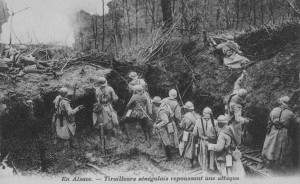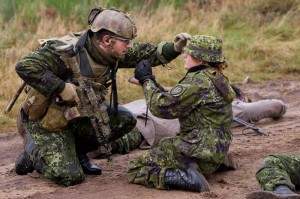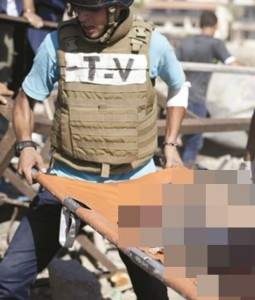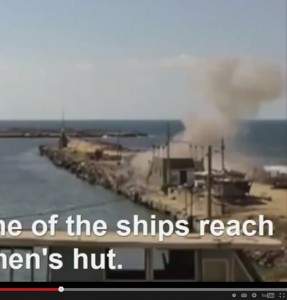The Hamas operational team, Gaza beach
October 19, 2023 by Thomas Wictor
I thought it might be useful for you to be given some context to the Hamas operational team that went into action on the Gaza beach, July 16, 2014. My goal is to help you understand that Israel is fighting a sophisticated enemy who makes up for his weakness in firepower by exploiting the media battlefield. In this arena the Israeli Defense Forces needs reform. It’s a problem that plagues the armed forces of all First World nations. The reason is that the press is so mentally ill that it automatically takes the side of whichever band of maniacs is fighting a technologically superior military.
It doesn’t matter how evil and savage the weaker party is. As long as a group can cast itself as downtrodden, the press will respond as brainlessly as Pavlov’s dogs and begin jabbering about “disproportionate force.” First World military leaders have yet to accept that the press is the propaganda wing of every rotten, murderous, intractably destructive organization out there. This love of primitive thuggery is irrational, so don’t let it upset you. There’s nothing you can do about it.
On Twitter, someone told a Twit that she should read my posts on Operation Four Little Martyrs. Here’s the response.
I’m sure this giant, pulsating brain reads pieces by Electric Intifada, the International Solidarity Movement, and similar outlets equally biased in the other direction. What Alisha Tariq doesn’t have the guts to admit is that she can’t tolerate information that might demolish her preconceived notions. The media is the same way. Reporters put their fingers in their ears and chant, “La-la-la, I can’t hear you!” Everything that doesn’t comport with the narrative is ignored.
Those of you who are furious and depressed that my Pallywood posts don’t get any media coverage should just put it out of your minds. I knew when I began writing them that nobody “legitimate” would pay attention.
But I now have incontrovertible evidence that the right people are reading them. So we may all have the last laugh on the press. Soon. Be patient and strong.
The Hamas operational team
In World War I (1914-1918), the Germans invented special forces and what are called “small-unit tactics.” Prior to about 1915, armies pretty much stood across a field from each other and blasted away with rifles and cannons until one side gave up. By 1915 the firepower was so great that armies dug trenches to escape all that flying metal. Now there were static lines that didn’t change for the next three years.
To break this stalemate, both the Allies and the Central Powers began experimenting with much smaller units. Here’s how most ground forces are broken down in the modern era:
Army - All the land forces of a nation, usually made up of numbered armies
Numbered Army - multiple army corps
Army Corps - two or more divisions
Division - two or more brigades
Brigade - two regiments
Regiment - three or four battalions
Battalion - at least three companies
Company - three or four platoons
Platoon - several sections or squads
Section or squad - two fire teams
Fire team - four to six soldiers
It was only in World War I that both sides began using the smallest number of soldiers capable of fire and maneuver, meaning the least number of men who could protect themselves by being broken down into one group that provided covering fire for the other group, which moved forward to engage the enemy. Both groups traded roles, leapfrogging each other.
In the German army, the “unit group” (Einheitsgruppe) was used, a team of up to sixteen men armed with one light machine gun, hand grenades, and rifles.
The French used the “half-section” of up to eighteen men, also armed with one light machine gun, hand grenades, and rifles. This is a half-section of Senegalese.
See their machetes? The Germans generally surrendered without a fight when the Senegalese were sent in.
In today’s First World armed forces, special operators draw on the World War I model. The US Army Special Forces or Green Berets has as its basic combat unit the Operational Detchment Alpha (ODA) of twelve men.
The British Special Air Service (SAS) Regiment uses a troop of sixteen men.
They’re allowed to wear whatever they want and use whatever weapon they want. These men of Task Force Black went on as many as ten hunter-killer missions a day in Iraq.
The Danish Jaegerkorpset follows the SAS example and builds on the sixteen-man troop as the primary element. As in the case of all special-operations forces, individual squads or fire teams can be deployed tactically.
So we’ve seen that since World War I, specialist units of highly trained men operate best in groups of less than twenty. This is how the Hamas Izz ad-Din al-Qassam Brigades—the military wing of this lovely political party—are organized.
It’s clear that the combat forces attack in teams of ten to twenty.
Operation Four Little Martyrs was a military action that included the use of explosives. This is the core team of Hamas operators.
The commander, a captain or lieutenant.
The second-in-command, a second lieutenant or sergeant.
Another sergeant, the demon in the tan shirt.
A Salafist bomber (who wounded himself).
It’s almost certain that this bomber also set off the first IED.
And the second IED. Bombers each have an individual modus operandus. Too many bombers spoil the production; this one alone managed to blow himself up. It’s very unlikely that Hamas would’ve used multiple bombers.
From his vantage point in the tents, the Salafist could’ve set off all three IEDs with cellphones, but he screwed up the third one. I’m thinking it didn’t go off at the same time as the second. He fiddled with it, and it exploded, mutilating the corpses of the three boys but also sending shrapnel into his chest and abdomen.
Guides (on the left).
Muscle (in the white shirt), to dispose of the incompetent Salafist bomber.
A lookout.
A “torpedo,” as my father would’ve called him, there to watch and intimidate.
The placer and remover of corpses.
Note the long nail on his right pinky finger. It’s a status symbol: In Arab cultures it means he’s wealthy and doesn’t do manual labor.
One official corpse photographer.
Another torpedo (right). This one’s a steroided killer; no doubt. Who stares like that in the middle of a medical emergency? He’s no longer human.
Another official corpse photographer (right) and another guide (center background).
The cameraman behind the boat (not pictured).
The cameraman who filmed the third IED (not pictured).
And the youngest member of the team.
That’s seventeen. Or sixteen, if you prefer to leave out Motasem-Muntaser-Moutaz Bakr due to his age and impressionability.
Sixteen is the same number as a World War I German “unit group,” an SAS troop, or a US Navy SEAL platoon. Don’t let the liars trick you. This was a military operation carried out by highly trained specialists.
The only reason I saw through it is because I’m a highly trained specialist. I’ve experienced such dishonesty and injustice that I immediately recognize them—when others are the victims. Therefore I became obsessed with proving what I knew to be true, that the Israeli Defense Forces did not kill those children.
Once I shouted it loudly and often enough, I got a lot of help. Exonerating the IDF was a team effort. I wouldn’t be surprised if there are about sixteen of us.
Click here for a timeline of the operation. Remember that this is a work in progress, so details change as more information comes in.













